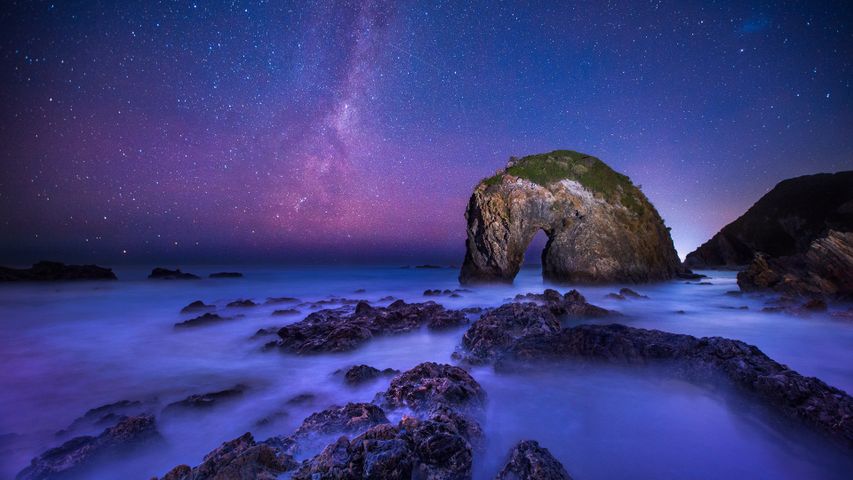Moon dog photographed at Hug Point Falls on the Oregon coast
© Ben Coffman/Tandem Stills + Motio
What’s going on in this sky?
When the sky is clear, and the moon hangs low in the horizon, you can sometimes spot a halo around it, like the one captured in this image from Hug Point Falls on the Oregon coast. And sometimes within that halo, you may also see a bright spot that appears to be a second moon. No, it's not the moon's long-lost twin, but an optical phenomenon called a paraselene, more commonly referred to as a moon dog or mock moon. This 'false' moon can appear when the real moon is at least a quarter visible and is bright enough for its light to refract off hexagonal-plate-shaped ice crystals floating in the atmosphere. Moon dogs are more commonly seen in winter months, when the ice crystals are more prevalent in the clouds.
The moon dog is the lunar equivalent of a sun dog, also known as a parhelion, and both appear as part of a related optical phenomenon called a 22-degree halo. Halos like these are also caused by crystal refraction in the atmosphere, and named for their apparent radius of 22 degrees, or about 10 diameters outside the moon and sun. A 22-degree halo is said to be visible up to 100 times per year, much more common than a rainbow.
Related Images
Bing Today Images





 The Milky Way over Horse Head Rock, New South Wales, Australia
The Milky Way over Horse Head Rock, New South Wales, Australia
 Vila Franca Islet, São Miguel Island, Azores, Portugal
Vila Franca Islet, São Miguel Island, Azores, Portugal
 Greater flamingos, Lüderitz, Namibia
Greater flamingos, Lüderitz, Namibia
 Arromanches-les-Bains in Normandy, France
Arromanches-les-Bains in Normandy, France
 Cala Luna beach, Sardinia, Italy
Cala Luna beach, Sardinia, Italy
 Fogo Island, Newfoundland and Labrador
Fogo Island, Newfoundland and Labrador
 Barrier reef off Grande Terre, New Caledonia, France
Barrier reef off Grande Terre, New Caledonia, France
 Mona Vale rockpool, Sydney, Australia
Mona Vale rockpool, Sydney, Australia

